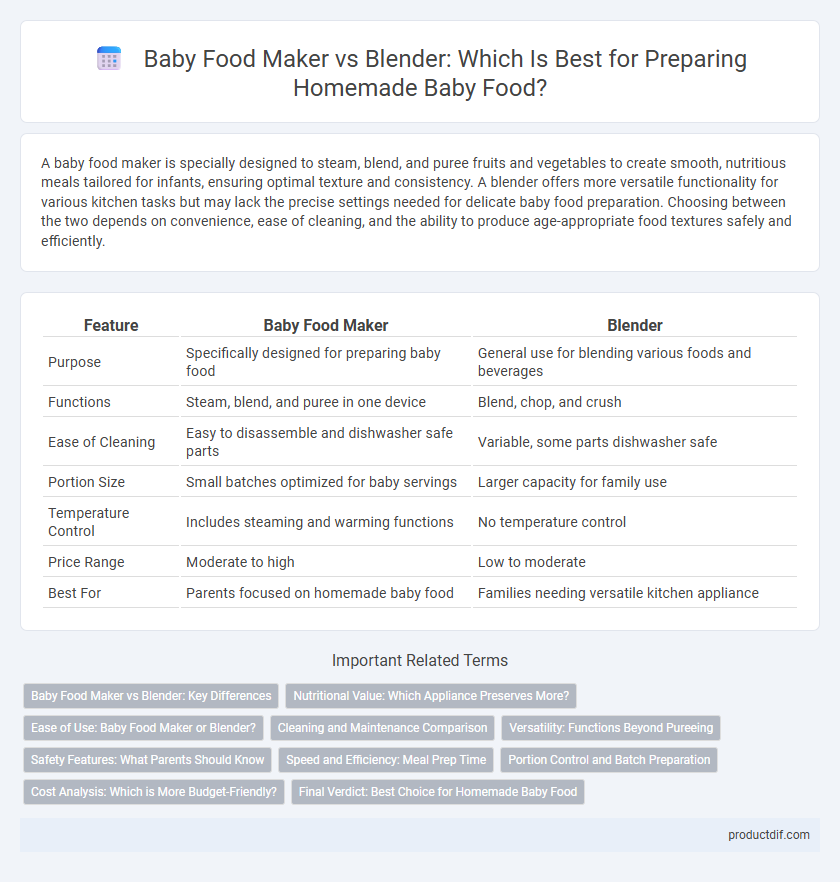A baby food maker is specially designed to steam, blend, and puree fruits and vegetables to create smooth, nutritious meals tailored for infants, ensuring optimal texture and consistency. A blender offers more versatile functionality for various kitchen tasks but may lack the precise settings needed for delicate baby food preparation. Choosing between the two depends on convenience, ease of cleaning, and the ability to produce age-appropriate food textures safely and efficiently.
Table of Comparison
| Feature | Baby Food Maker | Blender |
|---|---|---|
| Purpose | Specifically designed for preparing baby food | General use for blending various foods and beverages |
| Functions | Steam, blend, and puree in one device | Blend, chop, and crush |
| Ease of Cleaning | Easy to disassemble and dishwasher safe parts | Variable, some parts dishwasher safe |
| Portion Size | Small batches optimized for baby servings | Larger capacity for family use |
| Temperature Control | Includes steaming and warming functions | No temperature control |
| Price Range | Moderate to high | Low to moderate |
| Best For | Parents focused on homemade baby food | Families needing versatile kitchen appliance |
Baby Food Maker vs Blender: Key Differences
Baby food makers are specifically designed to steam, blend, and puree ingredients to the perfect consistency for infants, often including preset functions for easy preparation. Blenders offer versatile blending capabilities suitable for a variety of foods but may lack precise texture control and steaming options crucial for baby food safety and nutrition. Choosing a baby food maker provides convenience with targeted features, while blenders serve broader kitchen uses but require more manual adjustment for baby food preparation.
Nutritional Value: Which Appliance Preserves More?
Baby food makers are designed to steam and blend fruits and vegetables in a single process, which helps retain more water-soluble vitamins like vitamin C and B-complex compared to blenders that typically do not cook food. Steaming in baby food makers reduces nutrient loss by minimizing exposure to high heat and oxidation, preserving the natural flavor and nutritional content essential for infant development. In contrast, blenders chop raw ingredients, potentially causing more nutrient degradation due to longer exposure to air and the need for separate cooking methods.
Ease of Use: Baby Food Maker or Blender?
Baby food makers are specifically designed for parents, offering one-touch operation to steam, blend, and puree ingredients efficiently, reducing preparation time. Blenders require manual adjustments in speed and blending time, making them less intuitive for baby food preparation but more versatile for various recipes. The compact design and preset functions of baby food makers provide superior ease of use compared to traditional blenders.
Cleaning and Maintenance Comparison
Baby food makers often feature dishwasher-safe parts and simple designs that allow for quick, thorough cleaning, reducing the risk of bacteria buildup. Blenders, especially those with complex blades and multiple attachments, may require more time and effort to clean thoroughly and maintain peak performance. Regular maintenance of both devices ensures longevity, but baby food makers generally demand less frequent deep cleaning due to their streamlined functionality.
Versatility: Functions Beyond Pureeing
Baby food makers offer multifunctional capabilities such as steaming, blending, and reheating, tailored specifically for preparing nutritious baby meals, while blenders excel in versatile kitchen tasks like making smoothies, soups, and sauces for the entire family. Baby food makers often include preset programs and safety features to ensure optimal texture and nutrient retention for infants. Blenders provide higher power and speed options, accommodating a broader range of ingredients and cooking styles beyond baby food preparation.
Safety Features: What Parents Should Know
When comparing baby food makers and blenders, parents should prioritize safety features such as BPA-free materials, secure locking lids, and automatic shut-off functions to prevent accidents. Baby food makers often come with temperature controls and steam-cooking options, reducing the risk of overheating and preserving nutrients. Blenders may lack child-specific safety mechanisms, making baby food makers a more reliable choice for ensuring safe preparation of infant meals.
Speed and Efficiency: Meal Prep Time
Baby food makers are specifically designed to steam, blend, and puree ingredients quickly, reducing meal prep time significantly compared to traditional blenders. These devices combine multiple functions in one unit, allowing parents to prepare fresh, nutritious baby food faster and with less cleanup. High-powered blenders may offer speed but often require separate cooking steps, making baby food makers more efficient for busy families focused on quick meal preparation.
Portion Control and Batch Preparation
Baby food makers offer precise portion control with built-in measurement guides, ensuring consistent serving sizes ideal for infants' dietary needs. Blenders can handle larger batch preparation but often lack specific portioning features, requiring manual division of food. For efficient meal prep, baby food makers streamline small, controlled portions, while blenders suit bulk processing for families with multiple children.
Cost Analysis: Which is More Budget-Friendly?
Baby food makers generally offer a more budget-friendly option compared to blenders, as they are specifically designed for preparing small, nutritious portions and often include multiple functions like steaming and blending in one appliance. While high-powered blenders can be expensive and may require additional tools to achieve the same baby food consistency, entry-level blenders tend to be cheaper but lack specialized features. Considering long-term use, a baby food maker's efficiency and ease of cleaning can result in better value for parents focused on cost-effectiveness.
Final Verdict: Best Choice for Homemade Baby Food
The Baby Food Maker offers precise temperature control and built-in steaming, ensuring nutrient retention and safety ideal for homemade baby food. Blenders provide versatility but often lack the specialized features that simplify baby food preparation and cleaning. For parents prioritizing convenience and tailored baby nutrition, the Baby Food Maker remains the superior choice.
Baby Food Maker vs Blender Infographic

 productdif.com
productdif.com